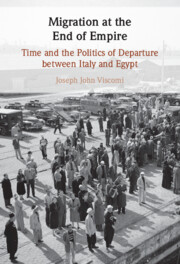434 results
5 - North Africa, Islam and the Great Civilisation
- from Part II - Forming an Africa Policy (1971–1975)
-
- Book:
- Pahlavi Iran's Relations with Africa
- Print publication:
- 27 June 2024, pp 119-149
-
- Chapter
- Export citation
2 - Iran, North Africa and Islamic Solidarity
- from Part I - Establishing Relations (c. 1957–1970)
-
- Book:
- Pahlavi Iran's Relations with Africa
- Print publication:
- 27 June 2024, pp 41-64
-
- Chapter
- Export citation
1 - Iran, Egypt and the Spectre of Nasserism
- from Part I - Establishing Relations (c. 1957–1970)
-
- Book:
- Pahlavi Iran's Relations with Africa
- Print publication:
- 27 June 2024, pp 19-40
-
- Chapter
- Export citation
4 - Becoming Refugees, 1954–1960s
-
- Book:
- Migration at the End of Empire
- Published online:
- 30 May 2024
- Print publication:
- 06 June 2024, pp 176-222
-
- Chapter
- Export citation
2 - Isolating Time
-
- Book:
- Migration at the End of Empire
- Published online:
- 30 May 2024
- Print publication:
- 06 June 2024, pp 83-130
-
- Chapter
- Export citation
5 - ‘Leave Us Our Memories!’ Nostalgia, Community, and the Politics of Departure
-
- Book:
- Migration at the End of Empire
- Published online:
- 30 May 2024
- Print publication:
- 06 June 2024, pp 223-262
-
- Chapter
- Export citation
Epilogue
-
- Book:
- Migration at the End of Empire
- Published online:
- 30 May 2024
- Print publication:
- 06 June 2024, pp 263-276
-
- Chapter
- Export citation
Introduction
-
- Book:
- Migration at the End of Empire
- Published online:
- 30 May 2024
- Print publication:
- 06 June 2024, pp 1-32
-
- Chapter
- Export citation
3 - Twice without a King
-
- Book:
- Migration at the End of Empire
- Published online:
- 30 May 2024
- Print publication:
- 06 June 2024, pp 131-175
-
- Chapter
- Export citation
1 - Extraterritoriality and Migrant Diplomacy in Egypt, 1861–1937
-
- Book:
- Migration at the End of Empire
- Published online:
- 30 May 2024
- Print publication:
- 06 June 2024, pp 33-82
-
- Chapter
- Export citation

Migration at the End of Empire
- Time and the Politics of Departure Between Italy and Egypt
-
- Published online:
- 30 May 2024
- Print publication:
- 06 June 2024
14 - Yom Kippur
- from Part III - Decline
-
- Book:
- To Run the World
- Published online:
- 30 May 2024
- Print publication:
- 30 May 2024, pp 392-426
-
- Chapter
- Export citation
2 - Law as Text
-
-
- Book:
- The Cambridge Comparative History of Ancient Law
- Published online:
- 09 May 2024
- Print publication:
- 30 May 2024, pp 20-72
-
- Chapter
- Export citation
15 - Sex in Nineteenth-Century Cairo
-
-
- Book:
- The Cambridge World History of Sexualities
- Published online:
- 26 April 2024
- Print publication:
- 16 May 2024, pp 307-328
-
- Chapter
- Export citation
Socioeconomic gradient in functional difficulties by domain among youth: evidence from Egypt
-
- Journal:
- Journal of Biosocial Science , First View
- Published online by Cambridge University Press:
- 07 May 2024, pp. 1-16
-
- Article
- Export citation
Modes of Cosmopolitanism in Waguih Ghali’s Egypt in Beer in the Snooker Club
-
- Journal:
- Cambridge Journal of Postcolonial Literary Inquiry , First View
- Published online by Cambridge University Press:
- 03 May 2024, pp. 1-19
-
- Article
-
- You have access
- Open access
- HTML
- Export citation
Chapter 4 - History peri physeos
-
- Book:
- Herodotus and the Presocratics
- Published online:
- 07 March 2024
- Print publication:
- 14 March 2024, pp 117-140
-
- Chapter
- Export citation
After the fall of the Egyptian Empire: review of the Third Intermediate Period settlement at Tell el-Retaba
-
- Article
-
- You have access
- Open access
- HTML
- Export citation
Chapter 2 - All Sides of the Moon
-
-
- Book:
- The Names of the Gods in Ancient Mediterranean Religions
- Published online:
- 23 February 2024
- Print publication:
- 07 March 2024, pp 37-58
-
- Chapter
- Export citation
6 - The Mareotis Area
-
-
- Book:
- The Nile Delta
- Published online:
- 15 February 2024
- Print publication:
- 22 February 2024, pp 219-248
-
- Chapter
- Export citation



